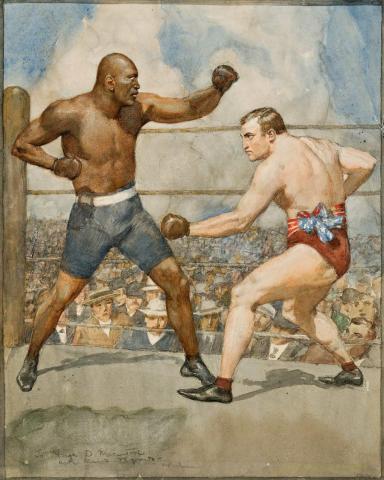THE JACK JOHNSON AND TOMMY BURNS FIGHT, 1908
Norman Lindsay
watercolour and pencil on paper
38.0 x 26.0 cm
signed lower right: Norman Lindsay
inscribed lower left: To Hugh D Macintosh [sic] /with kind regards - N.L.
Hugh McIntosh, Sydney
Private collection, Canberra until 1978
Private collection, Sydney
Trevor Bussell Fine Art Gallery, Sydney
Private collection, Sydney
Cover Illustration, The Lone Hand 1908, Heritage Collection 2008, memorabilia from the 1908 Burns and Johnson boxing match, State Library of New South Wales, 2008
Norman Lindsay cover illustration, and 'Some Studies of Tommy Burns', The Lone Hand, 1 December 1908, p. 211
One of the biggest sporting events in Australian history was the title fight between Jack Johnson and Tommy Burns - staged with splendid irony on Boxing Day, 26 December 1908. It captivated the world because it was the first time that a 'black' man fought for the prestigious World Heavyweight Boxing Championship, and its centenary is celebrated this year. Title fights of this magnitude were usually held in the USA or Europe. Its Australian presentation was due to the opportunistic brilliance of Sydney-sider Hugh McIntosh, an entrepreneur to rival any of today's. The background to the extraordinary interest in the fight lay in notions of white supremacy and the then right of Burns and others to avoid fighting non-whites. Johnson was from Galveston in Texas. Burns from Canada had been the heavyweight champion since 1906, but he did not want to face Johnson. Johnson persisted, and McIntosh offered Burns $30,000, then a fortune, to fight. Ironically, it was fought on Boxing Day! The venue was an open-air stadium at Sydney's Rushcutters Bay, with a crowd of 26,000 inside and another 40,000 outside. McIntosh refereed. The result was a forgone conclusion. Johnson played with Burns until round fourteen, when he blitzed him. The police ended the fight. Johnson got $1,500. McIntosh made a packet, and more with the film, which he toured in Europe and the USA.
A hustler of the first order, McIntosh was a friend of Norman Lindsay, who designed his book-plates. No doubt Lindsay's promotional watercolour for the front cover of that December issue of The Lone Hand was due to McIntosh's friendly persuasion. A highly popular magazine, its conception was due to Lindsay and Frank Fox, assistant editor of The Bulletin. Published in Sydney from 1907, it encouraged an independent Australian culture and supported local writers and artists. Contributors included the poet Hugh McCrae and art critic William Moore, illustrations were by Lionel and Norman Lindsay, Hans Heysen and B. E. Minns, and articles were written by such notables as Billy Hughes and Nellie Melba. Two articles in the December 1908 number described the fighters. Johnson was 'Six feet and a quarter of copper colored brawn and muscle'.1 His physical dominance was depicted by Lindsay. In contrast, Burns was 'barely 5' 7''. Moreover, Burns' face was said to suggest 'a portrait of Napoleon I.'2 Again Lindsay obliged, capturing the Napoleonic profile and smaller stature in a page of black-and-white studies and on the colour cover.3 He also portrayed Burns in his characteristic 'crouching style', an image of the tenacious underdog against the 'Galveston Giant', the American Negro champion. For some, the world had collapsed with the outcome of this event.
1. 'Jack Johnson Colored Champion of the World by 'Leonce'', The Lone Hand, op. cit., p. 216
2. Byrock, 'A World's Champion: an impression by 'Byrock'', The Lone Hand, Sydney, 1 December 1908, p. 210
3. 'Some Studies of Tommy Burns', ibid., p. 211
DAVID THOMAS
